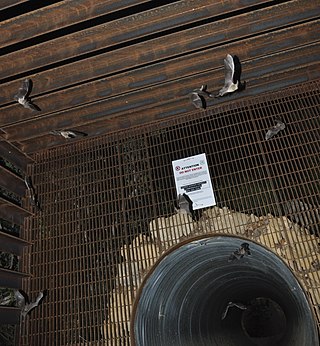Top Qs
Timeline
Chat
Perspective
Maternity colony
Temporary association of reproductive female bats From Wikipedia, the free encyclopedia
Remove ads
A maternity colony refers to a temporary association of reproductive female bats for giving birth to, nursing, and weaning their pups. The colonies are initiated by pregnant bats. After giving birth, the colony consists of the lactating females and their offspring. After weaning, juveniles will leave the maternity colony, and the colony itself will break apart. The size of a maternity colony is highly variable by species, with some species forming colonies consisting of ten or fewer individuals, while the largest maternity colony in the world in Bracken Cave is estimated to have over 15 million bats.

Remove ads
Benefits of a maternity colony
Maternity colonies are especially prevalent in temperate regions due to the thermal benefits of roosting with other individuals.[1] Outside of the winter months, non-reproductive females and male bats enter torpor for short periods to conserve energy when temperatures are below an optimum threshold. However, torpor is detrimental to reproductive females because it delays the development of the fetus and slows milk production.[1] Therefore, female bats are highly incentivized to maintain a constant body temperature. Roosting in a large group allows females to share body heat, lowering the energetic costs for individuals.
Remove ads
Risks of a maternity colony
Roosting in large groups brings risks to the members of a maternity colony. Predators such as hawks and owls can learn to anticipate the emergence of bats from a specific roost at sunset.[2] Smaller colonies are thought to be less risky than larger colonies, because the nightly emergence of bats would attract less attention.[3]
Species that form maternity colonies
| Common name | Scientific name | Range | Maternity colony size |
| Family: Vespertilionidae | |||
| Little brown bat | Myotis lucifugus | U.S., Canada | 107-349[4] |
| Southeastern myotis | Myotis austroriparius | Southeastern U.S. | 1000+[5] |
| Fringed myotis | Myotis thysanodes | Canada, Western U.S., Mexico | 40-200[6] |
| Indiana bat | Myotis sodalis | Midwestern U.S. | 30-300[7][8] |
| Northern long-eared bat | Myotis septentrionalis | Eastern U.S., Canada | 11-65[9] |
| Bechstein's bat | Myotis bechsteinii | Europe, Asia | 15-40[10] |
| Geoffroy's bat | Myotis emarginatus | Europe | <10-985[11] |
| Gray bat | Myotis grisescens | Southeastern U.S. | 100,000+[12] |
| Hodgson's bat | Myotis formosus | Asia | 82-200[13] |
| Eastern small-footed bat | Myotis leibii | Eastern U.S., Canada | ≤22[14] |
| Greater mouse-eared bat | Myotis myotis | Europe | 50-800[15] |
| Cave myotis | Myotis velifer | Southwest U.S., Mexico | 100-3,000[16] |
| Yuma myotis | Myotis yumanensis | Western U.S. | 100-1,000 [16] |
| Arizona myotis | Myotis occultus | Southwestern U.S. | 67[17] |
| Daubenton's bat | Myotis daubentonii | Europe, Asia | 6-144[18] |
| Long-eared myotis | Myotis evotis | Canada, Western U.S. | 4[19] |
| Tricolored bat | Perimyotis subflavus | Eastern U.S. | 9-40[20][21] |
| Parti-coloured bat | Vespertilio murinus | Europe, Asia | >30[22] |
| Big brown bat | Eptesicus fuscus | North America, Central America, the Caribbean | 20-100[23] |
| Serotine bat | Eptesicus serotinus | Europe, Asia | 5-200[24] |
| Northern bat | Eptesicus nilsonii | Europe, Asia | 10-70[25] |
| Silver-haired bat | Lasionycteris noctivagans | Bermuda, Canada, Mexico, U.S. | 8[26] |
| Townsend's big-eared bat | Corynorhinus townsendii | Canada, Mexico, U.S. | 40-55[27] |
| Virginia big-eared bat | Corynorhinus townsendii virginianus | Appalachian U.S. | 100-6335[28] |
| Ozark big-eared bat | Corynorhinus townsendii ingens | AR, OK, MO | 55-309[29] |
| Rafinesque's big-eared bat | Corynorhinus rafinesquii | Southeastern U.S. | ≤118[30] |
| Common noctule | Nyctalus noctula | Europe, Asia, North Africa | 20-50[31] |
| Common pipistrelle | Pipistrellus pipistrellus | Europe, North Africa, Asia | 92-262[32] |
| Nathusius's pipistrelle | Pipistrellus nathusii | Europe | 5-150[33] |
| Evening bat | Nycticeius humeralis | Eastern U.S. | ≤492[34] |
| Gould's wattled bat | Chalinolobus gouldii | Australia | 20-30[35] |
| Southern forest bat | Vespadelus regulus | Australia | <25[36] |
| Lesser long-eared bat | Nyctophilus geoffroyi | Australia | 3-23 [36] |
| Pallid bat | Antrozous pallidus | Canada, Western U.S., Mexico | 10-150[16] |
| Barbastelle | Barbastella barbastellus | Europe | 10[37] |
| Allen's big-eared bat | Plecotus phyllotis | Southwestern U.S., Mexico | 18-97[38] |
| Family: Rhinolophidae | |||
| Mehely's horseshoe bat | Rhinolophus mehelyi | Europe, Middle East | <60[39] |
| Lesser horseshoe bat | Rhinolophus hipposideros | Europe, North Africa, Asia | 2-750[40][41] |
| Rufous horseshoe bat | Rhinolophus rouxii | Asia, Southeast Asia | 50-60[42] |
| Family: Molossidae | |||
| Mexican free-tailed bat | Tadarida brasiliensis | U.S., Central America, South America | ≤15 million[43] |
| Big free-tailed bat | Nyctinomops macrotis | North America, Central America, South America | ≤2,000[44] |
| Family: Phyllostomatidae | |||
| Geoffroy's tailless bat | Anoura geoffroyi | Central America, South America | <150[45] |
| Family:Miniopteridae | |||
| Common bent-wing bat | Miniopterus schreibersii | Europe, Asia, Australia | 2,500-5,000[46] |
| Family: Pteripodidae | |||
| Bornean large flying fox | Pteropus vampyrus | Borneo | <15,000[47] |
Remove ads
References
Wikiwand - on
Seamless Wikipedia browsing. On steroids.
Remove ads
